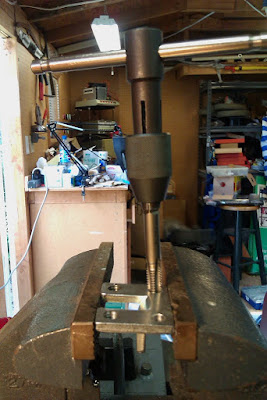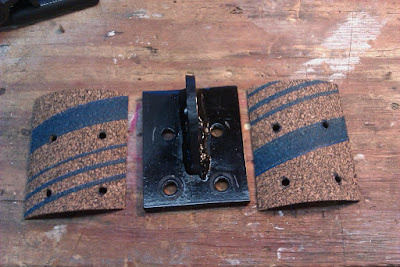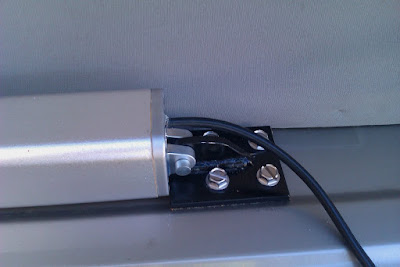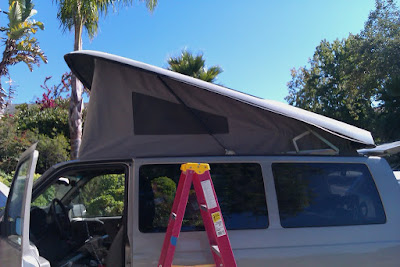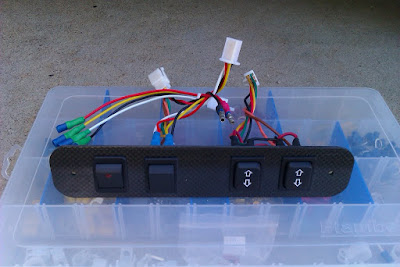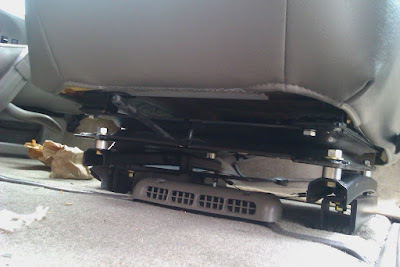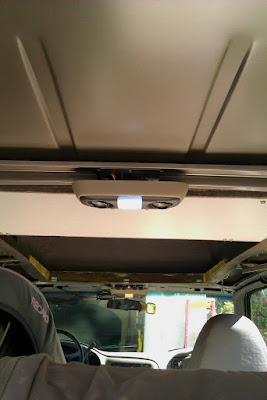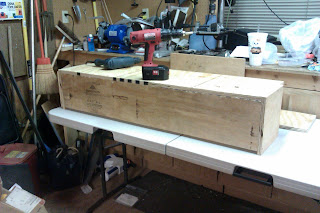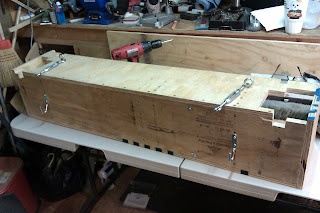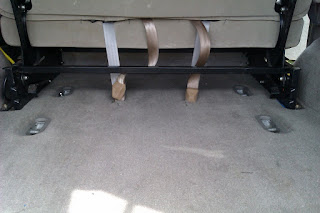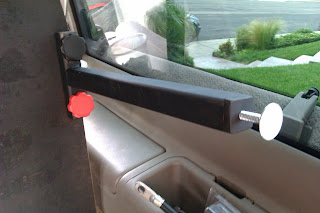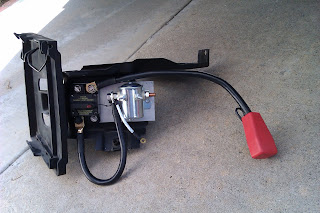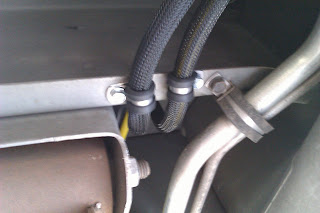Side Project: Swivel Passenger Seat
OK, with this update, I should be more or less "caught up" with documentation vs. the state of reality on the project, at least with respect to things with a significant time investment.
I finally got around to finalizing a GOOD fix for my issues with the swiveling seat. A rearward-facing seat (at least in the front passenger position) has been a core part of my interior design from almost the beginning. As soon as basic measurements and layout attempts proved to me that I would need to use some variant on a VW Weekender/Westy layout, I wanted to have the expanded living space of the front row facing aft.
As usual, more complete and larger images available on my
picasa web album. I will also make reference to some
other photos from the first draft installation.
My first attempt at this was to buy an off-the-shelf "bolt-in" swivel mechanism from
Discount Van-Truck (hereafter "DVT"). The idea is that this swivel plate bolts in between the stock seat and slider rails. Unfortunately for the Astro/Safari version, although the bolt-spacing is correct, it doesn't really take into account that the seat rails and seat bottom are curved. In order to accommodate this arch, I had to add some spacers to the bolts:
Combined with the swivel plate itself, this adds up to over three extra inches of seating height. This made it tight, even for shorter passengers. With the headliner removed to do all of my other work, I was pretty uncomfortable letting anyone too tall ride in that seat, lest they risk a head injury on exposed metal.
The other problem with this design is that the stock seat has some rearward rake built into the rails. This lifts the front of the seat and makes seating more comfortable, especially with the limited legroom. As you can see in the above picture, though, this incline is static and below the plane of rotation of the seat, so as you swivel the seat you go from a sideways slant to the front edge of the seat being much LOWER than the rear when fully swiveled. This was VERY uncomfortable.
Both of these "features" alone warranted a new plan of attack.
When I scored my donor van, I was pretty excited because it included TWO swivel seat bases. I also liked that these had a very beefy locking prawl so they felt securely locked when facing forward. Unfortunately they shared the same design flaw with the rear-rake built-in below the plane of rotation.

That wasn't the worst of it, though. It seems that GM had made some small but significant changes in the interior portions of the Astro/Safari van somewhere along the way. Despite having an identical outer unibody, the 1995 donor van had a few key differences to my 2003 van. Under the rear of my front seats there's a small duct outlet that blows HVAC air onto the feet of the passengers in the middle row. At first I thought I could utilize the GTRV donor swivel base by just notching the back of the plate to clear this outlet. I quickly went after it with a plasma cutter before I really understood what was going on. It turns out, that the vent outlet has ducting behind it (duh!), in the form of a very wide and flat plenum that sits under a good portion of the seat. This is why the passenger seat is up on those riser rails you can see in the first picture. Where the feet touch it is flat, but most everywhere else sits 1-2" higher with ducting, carpet, underlayment, etc. These flat-bottom seat bases just weren't going to work.
I looked at a variety of ways of just trying to put little "feet" on these bases to use them, but it always stacked up to making the passenger seat too high again. With all of the clearance needed for the various levers, there just wasn't an easy way to chop two or three inches out of the design without basically rebuilding it from scratch. Rather than head off down that road, I decided to leave the swivels intact for resale, and went after making the original DVT swivel base work "right".
After a lot of back and forth, I built these. They're pretty simple, just a couple of short sections of 1.5" x 2.5" tubing, with some angle stock welded on. The second project from my new-old welder. The more I work with it, the more I realize it will need a minor overhaul to fix the design issues with it. Fortunately others have gone ahead and documented how to do that.
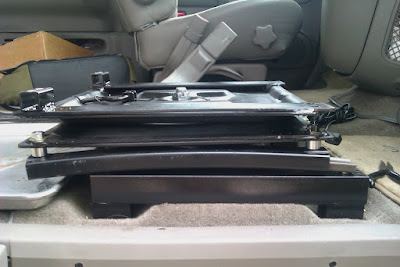
Here you can see everything stacked up. Unfortunately I still have the "curved" slider track under the swivel plate, but this was sort of necessary because if the slider was on top of the swivel, you'd have too much of the locking lever sticking out between your legs when the seat was fully rearward. This keeps the lever handles in a better position. More importantly, you can see that the plane of rotation is now mostly flat (depending a little on the slider position), and that the rake is built-in above the swivel plate. In this photo the swivel is "facing" rearward, and the 1" tubing spacers on the left raise up the front of the seat in all positions.

Here's the swivel plate "mid swivel", and the detail of the locking lever. One problem with both original swivel designs is that they only locked in the forward position. When facing rearward, reaching to grab something off the dash or trying to adjust your position with your legs would make the seat turn instead of moving your body, like pushing one of those shopping carts where all four wheels swivel, or a boat with no keel. Sort of annoying.
Fixing this was the easiest part of the whole project, I just nibbled out another notch with a cutting wheel on my grinder, so now the seat locks in the rearward position as well.
It is hard to see here unless you know what you're looking at, but the other minor improvement was to heat and bend the locking lever slightly, so that the handle comes "up" a bit and fits the contour of the lower seat a bit better. It gets it out of the way so you're not banging your heel on it if you cross your legs under while seated.

All told, the passenger seat now sits almost 3/4" lower than stock, instead of the 3+ inches higher than stock. The extra headroom just makes me feel that much safer for passengers since the GTRV reinforcing ring does seem to sit a tad lower than the original roofline, but I didn't want to drop things too much lest the armrest in the door be wildly out of whack against the arm rest on the seat. Building my brackets this way also moved the seat rearward about and 1.5 inches. This makes up for the awful passenger foot room more than you'd think, since the foot well is tapered. Any further and I was worried the upper seatbelt pickup would be too far forward.
As currently mounted, the edge of the seat just clears the B-pillar if I swivel the seat clockwise. If I want to go counter-clockwise, I have to move the seat back to the fully upright position first. I still could move the seat inboard another inch-and-a-bit if I use the other mounting holes, but so far this seems fine.
And now I can finally enjoy a proper "living area" facing the bench seat opposite with enough space for a table for eating or cards.
Two answer two popular questions:
1) No, I wouldn't use the seat in this position while traveling. The seatbelt anchors aren't really in the right place, and it would make my wife carsick faster than an alpine road anyway.
2) Not sure if I plan to do the same to the driver's seat or not. Because of my planned layout, my Edgestar fridge will most likely be behind the driver's seat when camping, so I wouldn't be able to swivel without a lot of shuffling around. I could test to be sure, but I also think the driver's seat would have to be inclined to an uncomfortable angle to clear the steering wheel anyhow. That said, having "facing" seating for four adults would be cool if we got stuck in a rain or something...









